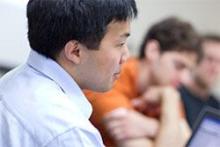Flexibility
- Emphasize independent study and scheduling choices
- Begin mentored experiences in research during the first 18 months, and provide multiple opportunities in the schedule for a dedicated four month research block and future ongoing research experiences
- Redesign elective structure to supplement educational experiences in core curriculum
Process of Teaching and Learning
- Focus on the amount of student-focused and self-directed learning time instead of calculating the amount of teaching time
- Promote student responsibility for learning
- Hold 3 interactive student-centered discussions/week
- Schedule a maximum of 20 contact hours/week (including student-centered discussions, laboratories, lectures, clinical skills, etc.)
- Emphasize clinical mastery through clinical exposure and simulation.
- Emphasize learning from multiple sources (including a rich array of web-based resources) and limit the use of an extensive syllabus
Content
- Initiate medical school education at the macro level with a focus on the social and behavioral context of health and disease in the broader population.
- Identify new educational focus at the interface of clinical medicine and public health
- Weave biomedical science, population health, scholarship, clinical medicine, leadership and civic professionalism longitudinally across the curriculum
- Create clinical experiences within biomedical and population sciences, as well as basic science instruction within clinical rotations
- Recommit to clinical mastery in the craft of Medicine
Assessment
- Change assessments from methods that emphasize passive learning (e.g., the memorization and recall of specific facts to methods that emphasize active learning and concept synthesis
- Define core competencies for clinical mastery
- Evaluate all elements of the new system rigorously
Faculty Support
- Provide development around interactive teaching and facilitation of student-centered discussions
- Foster clinical teaching faculty who directly observe students' clinical skills
- Provide financial and academic support for faculty curriculum leaders during curriculum design, implementation and ongoing delivery
- Provide enhanced financial support and academic rewards for the instruction of medical students


